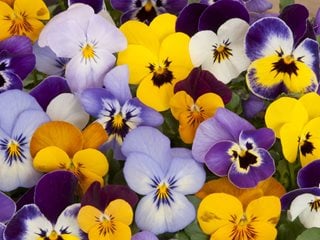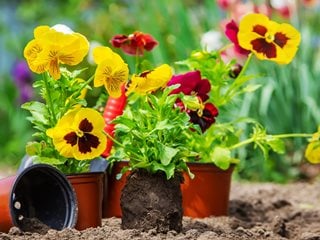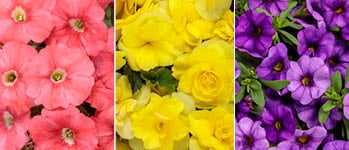A Guide to Growing Perfect Pansies
Pansies bring brilliant color to the cool-season garden. See some of our favorite varieties and get tips for growing, planting, and caring for pansy flowers.
Photo by Anjo Kan / Shutterstock.
“Nobody can keep on being angry if she looks into the heart of a pansy for a little while.” This wonderful quote from author Lucy Maud Montgomery perfectly describes the ability these captivating flowers have to lift our spirits, serving as an antidote for dreariness wherever they’re planted.
Appearing in garden centers in early spring and again in fall, these popular cool-season pick-me-ups are available in hundreds of varieties and a myriad of colors, with growth habits ranging from short and compact to trailing types suitable for hanging baskets and ground cover. And while all pansies love cool weather, you can also find extra-hardy winter-flowering varieties that will continue to bloom until buried by snow and then come back smiling the following spring.
On this page: Basics | Types | Planting | Care | Pictures | Using in the Garden | Frequently Asked Questions
On this page:
- BASICS
- TYPES OF PANSIES
- HOW TO PLANT PANSIES
- PANSY CARE
- POPULAR PANSY VARIETIES
- USING PANSIES IN THE GARDEN
- FREQUENTLY ASKED QUESTONS
BASICS
Botanical name:
Viola x wittrockiana
Plant type:
Short-lived perennial, usually grown as an annual
Zone:
Typically hardy down to Zone 6; will grow and flower all winter in Zones 8-11
Exposure:
Full sun to partial shade
Bloom time:
Spring, fall, early winter
Height/spread:
6 to 9 inches tall, 9 to 12 inches wide; trailing forms can spread up to 2 feet or more
Flower colors and characteristics:
The cheerful faces of pansies come in an amazing array of colors, ranging from white and pretty pastels to darker shades of purple, burgundy, and even black. You can also choose from solid colors, blotched or whiskered patterns, and all sorts of color blends.
TYPES OF PANSIES
Most pansies are categorized by flower size: large (3 to 4 inches), medium (2 to 3 inches), and multiflora (1 to 2 inches). The newest category is the trailing pansy, which includes plants with a spreading growth habit. Within each category you’ll find groups, or series, of pansies made up of cultivars with similar characteristics in a range of colors and patterns.
HOW TO PLANT PANSIES

Photo by Milena Khosroshvili / Shutterstock.
Where to plant:
In a sunny to partially shaded site. In hotter climates, plants placed in partial shade will continue to bloom longer into the summer.
When to plant:
Since pansies perform best in the cooler months, the best time to plant them is in early spring or fall. Because they will tolerate light frosts and freezing temperatures, pansies can be set out in the spring garden at least a month before the average last frost date in your area.
If planting in the fall, get them in the ground in time for the roots to establish before winter if you want them to survive and bloom again the following spring. That may be as early as late August in northern gardens and as late as October in the South.
Soil:
Plant in fertile, well-drained soil rich in organic matter.
Growing pansies in pots:
Pansies grow well in containers of all types as long as there are drainage holes in the bottom. However, avoid porous containers, such as ceramic and terra-cotta, if they will be exposed to freeze-thaw conditions. For a better show of blooms, use a high-quality potting mix that contains a slow-release fertilizer.
PANSY CARE
Watering:
Water plants well after planting and then keep well-watered during the growing season, especially during dry periods. Pansies like consistent moisture but won’t tolerate soggy soil, so allow the soil to dry somewhat between waterings. To minimize fungal disease, water early in the day so the foliage has time to dry before nightfall.
Amendments and fertilizer:
To promote flowering, add a balanced granular or slow release fertilizer to the soil at planting time. Incorporating compost or other organic matter into the soil will also help nourish your plants and allow for better drainage.
Pruning and deadheading:
Pansies rarely require pruning, but you should regularly deadhead spent blooms and their stems to conserve the plant’s energy and extend the flowering season. If your pansies begin to “stretch" or become leggy, don’t be afraid to pinch them back by up to one-third to encourage bushier growth.
Common pests and problems:
The most common disease problems of pansies include black root rot and fungal leaf spots, which are typically caused by overwatering, poor drainage, and watering plants late in the day. Common pests include pansyworms, cutworms, and aphids. Deer and rabbits also like to feed on pansies. (See these deer-proofing and rabbit-proofing tips.)
POPULAR PANSY VARIETIES
USING PANSIES IN THE GARDEN

Photo by: Betty Shelton / Shutterstock.
- Use fall-planted pansies as colorful complements to fall mums, ornamental grasses, or ornamental cabbage and kale.
- For an easy design shortcut, buy a “formula mix” of tried-and-true pansy color blends that look great together. Often sold at garden centers, these custom mix designs come in hues ranging from pretty pastels (try Imperial™ Antique Shades) to fall-friendly blends (such as Delta™ Pumpkin Pie Mix).
- Plant pansies in pots along with herbs, chard, leaf lettuce, and other garden edibles that flourish in cool weather. Not only will the colorful blooms add nice color, they can also be harvested at the same time for salads and other culinary uses.
- In the spring garden, pansies are the perfect companions for spring-blooming bulbs such as tulips, daffodils, and hyacinths. After the bulbs fade, pansies will continue to bloom for weeks and help disguise the dying foliage, especially if you plant fast-growing trailing varieties.
- Other cool-season flowering plants that pair well with pansies include snap dragons, dianthus, sweet alyssum, nemesia, and lobelia.
FREQUENTLY ASKED QUESTIONS
Are pansies annuals or perennials?
Pansies are typically classified as biennials, or short-lived perennials, because they will sometimes return for a second season of bloom, especially in areas with cool summers and moderate winters, such as the Pacific Northwest. However, in climates with harsh winters or blazing hot summers, pansies should be treated as annuals since they are unable to survive through extreme cold or heat. (See: Understanding the Difference Between Annual and Perennial Plants.)
Should I grow pansies in sun or shade?
For the best blooms, pansies need about 6 hours of sun daily. In warmer zones (zone 7 and above), plant them in a spot where they get morning sun but are shaded from scorching afternoon rays.
Can pansies survive frost?
Despite their tender appearance, pansies are miraculously frost-tolerant and will continue to produce buds and flowers at temperatures as low as 20 degrees F.
What’s the difference between pansies and violas?
Pansies are a hybrid of many different viola species, so botanically they are a type of viola plant. Although pansies look a lot like violas (see: 8 Annual Violas to Grow in Your Garden), they have larger flowers and can be found in a greater array of colors. Another way to tell the difference is by the petals. All members of the Viola genus have five-petaled flowers, but pansy blooms have four petals pointing up and one pointing down, while violas have two petals up and three down.
Why do pansies stop blooming in summer?
Pansies flourish in cool weather and will wither quickly once hot weather arrives. Often it’s best remove your fading pansy plants and replace them with summer-flowering annuals. However, if your pansies are planted in partial shade and given adequate moisture, they may survive through the summer and rebloom once cooler weather returns in fall.
Can I grow pansies from seed?
Pansies are easy to start from seed, but take a long time to mature. For spring blooms, start the seeds indoors about 12 weeks before the last frost date in your area (or in southern gardens, sow the seeds outdoors in garden beds in the fall). For fall flowers, you can sow the seeds outdoors in the garden in late summer. Learn more about growing your own plants from seed.
Are pansy flowers edible?
Yes! As long as you haven’t treated your pansies with chemical pesticides, their flowers—sepals and all—are edible and have a mild, slightly minty flavor. Try pansy flowers in salads, as a garnish for foods and beverages, or candied in desserts. Learn more about edible flowers and see recipes and uses.
RELATED:
Annual Flowers












